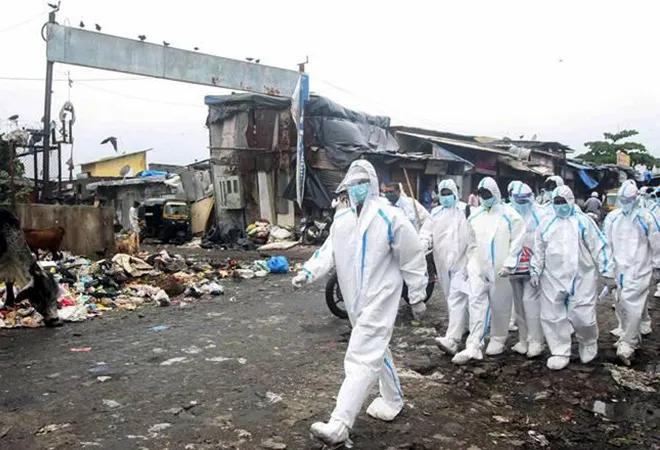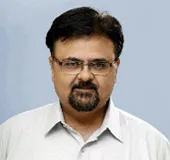-
CENTRES
Progammes & Centres
Location
The recent spate of top IAS transfers in the Mumbai Metropolitan Region has exposed Maharashtra’s haphazard handling of the pandemic

The exploding number of Covid-19 cases in the satellite cities of Mumbai, which are fast outnumbering the country’s commercial capital in terms of the spread of the contagion, has revealed glaring gaps in the state’s response strategy to the pandemic. In what appears to be a game of chess that is bereft of thoughtful strategy, the government of Maharashtra has resorted to rampant bureaucratic shuffling across the civic bodies of the Mumbai Metropolitan Region (MMR). In certain cases, the state has even unequivocally admitted that the transfer of the administrative cadre was undertaken “to tackle the Covid-19 situation effectively in these civic bodies”.
The shuffling of the babus began on 7 June, with the unexpected shunting out of the municipal commissioner of Mumbai. He was transferred as the Additional Chief Secretary in the state’s Urban Development (UD) department. In exchange, the Principal Secretary of UD was appointed as the commissioner of Municipal Corporation of Greater Mumbai (MCGM). The ousted commissioner reportedly fell out of favour with the former Chief Secretary on several decisions pertaining to the lockdown, the failure of the civic body to ensure adequate number of beds in municipal hospitals and also for overriding a notification for reopening liquor shops issued by the latter. The two were also known to be at loggerheads on several other issues in the past.
The second round of reshuffle happened on 20 May with the simultaneous transfers of the municipal commissioners of Panvel and Ulhasnagar and two additional municipal commissioners of Thane Municipal Corporation. Of these, one additional commissioner of Thane was appointed as the municipal commissioner of Ulhasnagar, while the incumbent commissioner of Ulhasnagar was given the charge of the Panvel Municipal Corporation. The Panvel city commissioner, in turn, was moved to Thane as an Additional Municipal Commissioner. These transfers came at a time when all the three cities had just begun to witness an increase in the number of Covid-19 cases. The cases in Thane had jumped to over 1,300 on 19 June from merely 300-odd cases in the first week of May. Panvel and Ulhasnagar, on the other hand, had just started registering their initial surge with 246 and 137 cases respectively on 19 June.
On 23 June, the state announced yet another list of transfers in the hope that the juggling of the officials will help arrest the outbreak. The newly appointed commissioner of Ulhasnagar, who had not even completed one month in the position, was given marching orders. On the same day, the municipal commissioners of two other key cities in the MMR – Navi Mumbai and Mira-Bhayandar –were transferred. But within one month, the Ulhasnagar episode was repeated in Navi Mumbai. The city got its second ‘new’ commissioner on 14 July as the one appointed on 23 June too, was unceremoniously stripped of his charge.
This chessboard approach has failed to yield the desired results. While Mumbai, endowed with one of the best public health infrastructures in the country, has shown signs of a gradual reduction in the total case load over the past couple of weeks, the rest of MMR has witnessed a worrying escalation of the outbreak. Though Mumbai still has a far greater number of cases – 97,950 as on 16 July, it has not only improved the recovery rate to more than 55 percent, but increased the doubling rate to 50 days. The total case count in the MMR on the whole, including Mumbai, stood just a little short of 200,000 cases as of 16 July, which means that now the hotspot has shifted out of Mumbai to its satellite towns. As of 16 July, Navi Mumbai has recorded 10,546 total cases and 322 deaths with a doubling rate of 22 days. Kalyan-Dombivali has recorded a total of 14,598 cases and 225 deaths with a doubling rate of 14 days, while Thane has recorded a total of 14,832 cases and 523 deaths, with a doubling rate of 23 days. The total number of cases in Pavel and Ulhasnagar too have escalated from just 246 and 137 to more than 5,000 each during the period of 19 June to 17 July.
Besides Mumbai city, which falls under the jurisdiction of the MCGM, the MMR has eight other municipal corporations of Thane, Kalyan-Dombivali, Navi Mumbai, Ulhasnagar, Bhiwandi-Nizampur, Vasai-Virar and Mira-Bhayandar. It also has nine Municipal Councils of Ambarnath, Kulgaon-Badalapur, Matheran, Karjat, Panvel, Khopoli, Pen, Uran, and Alibaug, and more than 1,000 villages dotting the Thane and Raigad districts. Geographically, the MMR is nearly ten times the size of the Mumbai city, and as per census 2011, home to a population of round 0.9 million, which is about 20 percent less than Mumbai’s population. Though the entire MMR thus has fragmented governance and administrative structures, for the people, it is a homogenous entity. The suburban trains in Mumbai carry a commuter load of nearly eight million daily, a majority of whom are people who daily travel to Mumbai to work from across the MMR.
"The suburban trains in Mumbai carry a commuter load of nearly eight million daily, a majority of whom are people who daily travel to Mumbai to work from across the MMR."
Thanks to the excessive focus on Mumbai of the Mumbai Metropolitan Region Development Authority (MMRDA), the state’s metropolitan planning agency to ensure equitable regional development, the rest of the cities in the region have perennially suffered from government apathy. While Mumbai stands out with its relatively robust civic health infrastructure, the rest of the MMR cities are grossly underserved and unprepared to tackle a public health crisis of this unprecedented nature and scale. While Mumbai is gradually reopening, the seven other municipal corporations of the MMR have re-imposed the lockdown with severe restrictions on movement of people and vehicles up to 24 July. Nearly all of them – including the better-off Thane and Navi Mumbai, are facing shortage of hospitals, beds, critical care equipment, testing labs and medical professionals. Municipal chiefs of several corporations have admitted that the resource crunch is forcing them to send not only patients, but even a bulk of their test swabs to hospitals and labs in Mumbai. Given the nature of the disease, if the growth of cases in these areas is not controlled urgently, the inevitable movement of people across MMR is bound to also upset the reassuring gains achieved by Mumbai in somewhat flattening the curve. But to do this, the state has to put its weight behind capacity building in the towns of the metropolitan region. Reorganisation of civic administration by shifting the city bosses as if they are pawns on a chessboard will continue to be a futile exercise.
In a much-delayed reaction, the state has finally taken notice of the grave situation in Mumbai’s poorer siblings in the MMR. It was only last week that Aaditya Thackeray, the state’s tourism and environment minister and son of the Chief Minister dashed off to Kalyan and discussed the capacity constraints with the MMR’s civic chiefs. He announced the rollout of the ‘chase the virus’ campaign on the lines of the Dharavi model and promised increased testing facilities, enhanced contact tracing and ramping up of basic health infrastructure including hospital beds, critical care facilities and establishment of ward-level fever clinics.
"A fresh look at the entire governance model of the MMR is inevitable, as the fragmented approach has bred inequity and a bias for Mumbai. Towns and cities in the MMR can no longer be looked at in isolation"
These are welcome, but quick-fix, measures to overcome the current crisis. A fresh look at the entire governance model of the MMR is inevitable, as the fragmented approach has bred inequity and a bias for Mumbai. Towns and cities in the MMR can no longer be looked at in isolation. Governance, administration, planning and provisioning of physical and social infrastructure and basic amenities and services must be urgently thought of for the whole of MMR as a composite urban entity. An ‘Empowered Mayor’ model has for long been discussed for Mumbai. Perhaps it is time for looking at MMR from that lens. Till such time such fundamental and sweeping changes are made, the political masters will continue to make civil servants the scapegoats for their failures.
The views expressed above belong to the author(s). ORF research and analyses now available on Telegram! Click here to access our curated content — blogs, longforms and interviews.

Dhaval is Senior Fellow and Vice President at Observer Research Foundation, Mumbai. His spectrum of work covers diverse topics ranging from urban renewal to international ...
Read More +